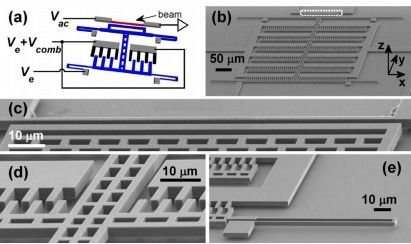According to new research in mice, aerobic exercise may actually reverse aging’s toll on essential muscle stem cells.


The Airspeeder vehicle, which weighs about 550 pounds, uses a battery pack that can be swapped out during the race. The packs are expected to last for about 15 minutes. Four 32-horsepower electric motors propel the cars to a top speed of about 125 miles per hour. The vehicle tears through the air between about 15 and 130 feet off the ground.
Matt Pearson, founder of Alauda and the Airspeeder series, said:
In economic terms, the eVTOL (Electrical Vertical Take Off and Landing) sector has the potential to be worth €1.37 trillion ($ 1.5 trillion) by 2040. It is backed by some of the biggest names in aviation, technology, and automotive.
:oooooo.
A technique developed by Purdue University scientists could allow doorknobs and other metal surfaces to be modified in a way that would kill bacteria on contact.

Underwater explorers found a 150-foot-long (45 meters) siphonophore — a translucent, stringy creature that, like coral, is made up of smaller critters — living in a submarine canyon off the coast of Australia. It’s “seemingly the largest animal ever discovered,” they said.
Every individual siphonophore is made up of many little “zooids,” which each live lives that are more similar to animals we’re used to talking about, albeit always connected to the larger colony. Zooids are born axsexually, and each one performs a function for the siphonophore’s larger body, according to a research article published in the journal Developmental Dynamics in 2005. Linked together in long chains, the colonies were already known to reach lengths of up to 130 feet (40 m) according to the Monterey Bay Aquarium — though each siphonophore is only about as thick as a broomstick.
The new, record-setting siphonophore was one of several discoveries made by a team aboard the research vessel Falkor while exploring deep-sea canyons near Australia’s Ningaloo Coast.

This is huge news… heart disease is the number one killer globally.
“They found that Myc-driven activity in heart muscle cells is critically dependent on the level of another protein called Cyclin T1, made by a gene called Ccnt1, within the cells. When the Ccnt1 and Myc genes are expressed together, the heart switches into a regenerative state and its cells start to replicate. The results are published today in the journal Nature Communications.”
Researchers trying to turn off a gene that allows cancers to spread have made a surprising U-turn. By making the gene overactive and functional in the hearts of mice, they have triggered heart cell regeneration. Since adult hearts cannot usually repair themselves once damaged, harnessing the power of this gene represents major progress towards the first curative treatment for heart disease.
“This is really exciting because scientists have been trying to make heart cells proliferate for a long time. None of the current heart disease treatments are able to reverse degeneration of the heart tissue—they only slow progression of the disease. Now we’ve found a way to do it in a mouse model,” said Dr. Catherine Wilson, a researcher in the University of Cambridge’s Department of Pharmacology, who led the study.
The cell cycle—through which cells make copies of themselves—is tightly controlled in mammalian cells. Cancer develops when cells start to replicate themselves uncontrollably, and the Myc gene plays a key role in the process. Myc is known to be overactive in the vast majority of cancers, so targeting this gene is one of the highest priorities in cancer research. Much recent research has focused on trying to take control of Myc as a means of cancer therapy.

In the midst of the coronavirus epidemic/pandemic it bears remembering the application of hyperbaric oxygen therapy to the last major pandemic that impacted the United States in 1918, the Spanish Flu Pandemic. Death was primarily by pulmonary infection and its attendant hypoxemia and respiratory failure. The first application of hyperbaric medicine to a Spanish Flu victim was likely also the first application to a human being in the United States. In 1918 Dr. Orval Cunningham of Kansas City was brought a dying friend of a fellow physician. The patient was moribund and blue. Before Cunningham could perform his planned animal experiments he was asked to treat this dying patient. With just a one-hour treatment with compressed air at 1.68 atmospheres absolute the patient experienced improvement. Combined with additional hyperbaric treatments over the next 3 days this patient’s life was saved. Others followed.
Today’s coronavirus’ mortality is due to pulmonary infection and respiratory failure. While there are differences between the Spanish Flu and coronavirus the primary pathology is in the lungs, the first organ of contact with hyperbaric therapy beyond the skin. The ability of hyperbaric oxygen to penetrate inflammatory pulmonary secretions allows adequate oxygen to reach the blood while inhibiting the inflammatory process. Applied correctly, hyperbaric therapy may have utility in coronavirus patients similar to its life-saving history with the Spanish Flu. Harch Hyperbarics Inc 504 309‑4948 www.hbot.com
Some doctors are questioning the way ventilators are being used for people with serious cases of COVID-19. Why? More data shows a high death rate for patients treated under current ventilator practices.
At the same time, these doctors are saying their patients behave more like they have high altitude sickness than a viral infection. They talk about two different types of COVID-19 patients with differing severe lung problems.
While some patients respond to treatment as expected, doctors also describe patients whose lungs seem relatively fine, but who still can’t get enough oxygen into their blood. These patients may make up the majority with severe infections.

Neuroscientists at MIT have now identified types of cells that encode distinctive segments of an overall experience — a memory. The brain stores these chunks of memory in the hippocampus They are activated whenever a similar experience takes place, and are distinct from the code that stores detailed memories of a specific location. Learn more.

Could be made into a generator of some kind :3.
One of the strangest effects to arise from the quantum nature of the universe is the Casimir force. This pushes two parallel conducting plates together when they are just a few dozen nanometres apart.
At these kinds of scales, the Casimir force can dominate and engineers are well aware of its unwanted effects. One reason why microelectromechanical machines have never reached their original promise is the stiction that Casimir forces can generate.
On the other hand, many engineers hope to exploit the Casimir force. Various theoretical models predict that the force should be repulsive between objects of certain shapes, a phenomenon that could prevent stiction.

A neutron star is the dead husk of a star more massive than the sun, but not large enough to become a black hole upon its demise. These stars are between 10 and 29 solar masses during their active lifetime. When they exhaust their nuclear fuel and go supernova, all that’s left is the ultra-dense collapsed core. We call that a neutron star.
The wild physics inside a neutron star are down to the incredible mass packed into such a small space. A neutron star might have twice the mass of our sun packed into an object just a few miles across. The crush of gravity contorts and squeezes neutrons into unusual configurations, based on the models developed by scientists studying neutron stars.
Scientists currently believe that neutron stars have layers characterized by different configurations of distorted neutron matter. For whatever reason, researchers have decided to name the various structures after pasta. Near the surface there’s gnocchi, which are round bubble-like neutrons. Go a bit deeper, and the pressure forces neutrons into long tubes called spaghetti. Go further down, and you have sheets of neutrons called lasagna. That’s just the start of the Italian-inspired interior of neutron stars.